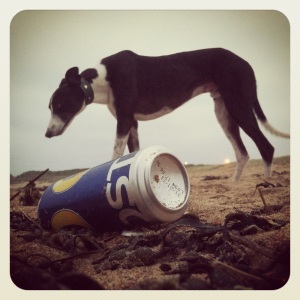Aluminium is the most common metallic element on earth, making up about 8% of the earth’s crust. Only oxygen and silicon are more abundant.
It occurs in various chemical forms in rocks and soils, in vegetation, in water and in the air, but it doesn’t occur anywhere in its pure form. It has to be extracted from its ore, a clay-like substance, which is mined and then ‘smelted’ in a very energy-intensive process.
Being so difficult to isolate, aluminium wasn’t discovered until 1807 by Sir Humphry Davy. Then it wasn’t until 1886 that an economically viable process was developed to extract aluminium.
86 per cent of drink cans sold in the UK are made from aluminium — that’s nearly 8 billion cans every year!
It takes aluminium about 400 years to break down naturally.
Why take photos of aluminium cans using my phone? A good question. Most of you probably think I’m barking mad but never mind. I took this following picture first, simply because I saw the can washed up on the beach and thought it looked like a good photo opportunity.
Normally, I’m the type of person who picks rubbish up and puts it in the nearest bin I pass. Too many people complain about things but do nothing about whatever it is they’re ranting about. But I liked the way sunlight reflected from the aluminium surface, or I liked the ridiculousness of a discarded can being inside a picture of a great view.
Once I’d started I found it difficult to stop. Suddenly I was seeing aluminium cans everywhere. There were photo opportunities on every dog walk, every shopping trip. I’d stop the car whilst driving over the dales or the Northern Pennines as soon as I spotted a can by the roadside.
Holidays with the family and a weekend away with the wife, free from children, provided no respite.
Sometimes, I went searching for aluminium cans, on occasions finding particularly beautiful spots and finding myself disappointed that nobody before me had the disgraceful nerve to drop a can into such natural surroundings.
My children started taking the micky out of me. Occasionally, they’d run up in front of others and say “Dad, Dad…I’ve found a can for you to take a picture of.” My wife raised her eyebrows. I got down on one knee and tried to see things from a can’s point of view.
Coca Cola were by far the most popular of discarded cans. After that was Fosters. Carling were pretty popular too. I wondered if that was because these drinks were drunk the most, or if there was something about the people who drank them that meant they were more likely to simply chuck the can rather than keep it on them and put it in the bin.
Eventually though, I simply tired of taking pictures of aluminium cans. The photographs you find in this blog are simply a small percentage of the overall number, believe me. I started dreaming of having an exhibition of discarded cans, smirked at the irony of it all. I imagined being in the newspaper, famous for pictures of cans taken on a phone rather than for the hours and hours, months and months and years and years I’ve put into writing books. But nobody would be so daft to do that would they? And the pictures are probably not good enough anyway.
Aluminium can be recycled again, and again, and again. As one of the few “infinitely recyclable” materials in the world, it can be recycled with no loss of quality whatsoever. In fact, over three quarters of the aluminium ever produced is still in use today.
So do me a favour will you? Do us all a favour please. Next time you finish slugging your fizzy pop or lager, pop the can in the bin will you? Preferably a recycling one if you can find one. I’ve had enough of photographing aluminium cans on my phone. I’ve moved onto public toilets this time. But before you call the police on me, I promise you I only ever take a picture when there’s nobody around. Perhaps, on second thoughts, I should stick to writing books.






























Hi Richard,
Working with the wildlife trust, we clear large areas of weed and scrubland from bird habitat. We constantly find cans amongst the rubbish. Whereas yours are individual, I think we have found colonies of them. The most popular were Carling, usually at th side of laybys. The area hadn’t been cleaned for some time as we also found a crisp packet dated 1996.
I hope it isn’t as catching as your photographing cans. Then I will cry.
Carl